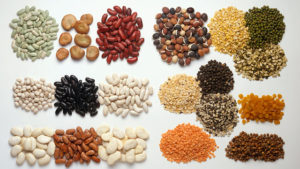By: Dianna Yanchis, BSc (Nutrition)
Reviewed by Andrea Miller MHSc, RD
Protein is an essential nutrient that performs a variety of important functions in the body. This includes cell growth and repair, forming the structural component of tissues, producing hormones, building enzymes, maintaining fluid and electrolyte balance as well as pH balance, producing antibodies to protect against disease and use as an energy source. Protein can also act as building materials for bones, ligaments, tendons, muscles and organs.
Protein is abundant in the Canadian diet. Meat and dairy products including beef, poultry, fish, eggs, tofu, milk, cheese and yogurt all contain high levels of protein. A significant amount of dietary protein also comes from cereals, grains, nuts and legumes. It is important to incorporate both plant and animal based proteins into the diet. When choosing protein sources try to include lean meats, two servings of fish per week, and meat alternatives like dried beans, lentils and tofu. Protein rich foods provide many essential vitamins and minerals including iron, zinc and magnesium.
Dietary recommendations state that protein should contribute 10-35% of the total daily caloric intake. The amount of protein an individual needs can vary based on weight, activity level, presence of disease or illness, age and sex. Vegetarians need to pay extra attention to food choices, to ensure they are consuming adequate plant-based proteins. Protein needs can generally be met by consuming a variety of foods from all food groups. Most individuals can meet protein needs through diet and do not require protein supplements.
So what’s all this talk about protein shakes, powders, bars and supplements you ask?
Protein supplements have been found to be popular among athletes and people who want to gain muscle mass. However, research shows that most people, even athletes, can meet protein requirements without the use of protein supplements or powders. Protein supplements can be costly and have little benefit over a balanced diet. Additionally, many protein powders and bars are high in sugar, and saturated fat. Protein needs can be met by choosing a variety of protein-rich foods from all food groups.
Aim to divide your intake of protein-rich foods, over three meals and two to three snacks, daily. Our use of protein is more efficient when it is spread out over all meals and snacks. Keep portions to three ounces with meals and one to two ounces with snacks. Use these handy resources to measure your portions.
The bottom line: choose a variety of lean sources of protein, spread out over the day. Balance protein rich foods with whole grains, fruits and vegetables, milk products and small portions of fat. For more information regarding protein click here.


